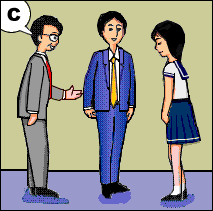| |
There are different levels of politeness in the Japanese greetings. Some greetings are more polite than others.
Polite greetings are usually used by younger persons to greet older
persons, and plain greetings are used between peers and by older
persons to greet younger ones. In more general terms, this distinction
reflects hierarchical differences within a community in which the
subordinates/juniors (e.g., students) pay respect to the superiors/seniors
(e.g., teachers). (The Japanese characters below will be formally introduced in Lesson 2.)
Some greetings do not have superior/subordinate distinctions and
are used regardless of the hierarchical positions within a community
as shown below.
There are different levels of politeness in saying good-bye.
Requests:
Expressions when you hand over something:
Thank-you expressions range from casual to more polite ones. (1) ありがとう is a casual "Thank you" commonly used for peers, friends and colleagues. By adding ございます at the end as in (3), you can make it sound more polite. Women tend to use more polite expressions. By adding どうも in front as in (4), you can make it sound more careful. どうも can be used by itself as in (5).
There are other expressions not listed above that can be used in more formal situations.
You are welcome:
|
| |
A title さん pronounced as /san/ is used after other people's name. This is a generic title for men or women, married or single, and it can be used after one's first name or last name. No title is used after your own name. Don't put さん /san/ to your own name!
To address one's teacher, the title せんせい /sensei/ is used. Frequently, people use this title to show their respect to that person regardless of whether or not he/she is in fact a teacher.
A. Referring to oneself
 |
B. Referring to others
 |
C. Referring to teachers
 |
| かわむら |
かわむらさん |
かわむらせんせい |
| Kawamura. |
Mr. Kawamura.
(Also Ms. Kawamura) |
Prof. Kawamura |
|